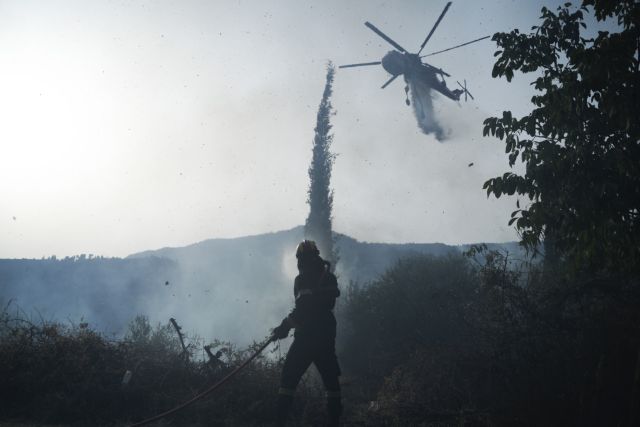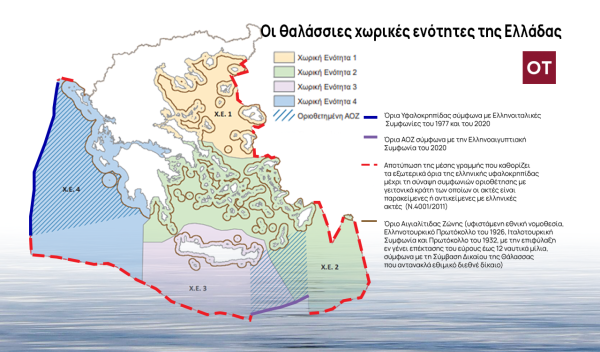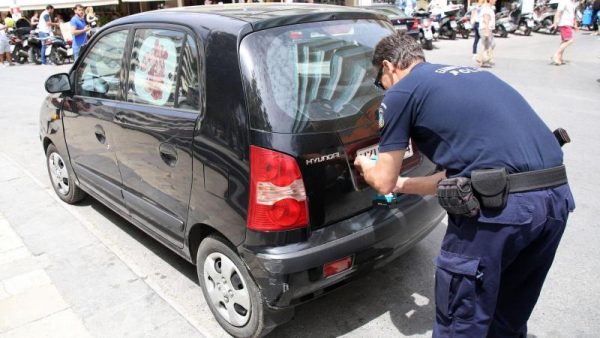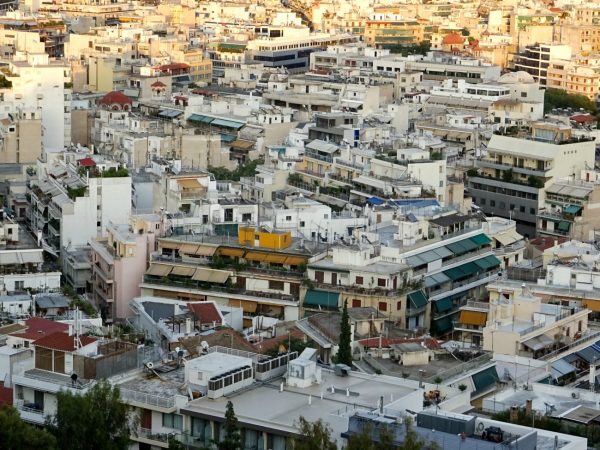
The fire in Varybobi caused a catastrophe in Northern Evia. The salvation of Ancient Olympia led to the uncontrolled resurgence in Varybobi, the difficult containment of which increased the destruction in the Municipalities of Mantoudi and Istiaia. And the effort to reduce the burning areas in Limni, Kapandriti, and Gortynia increased the line of fire in Gythio and Melpeia, in Messinia.
This “vicious cycle” of fire fronts in Southern Greece on the fateful eight days of August 3-11 caused, in combination with the surprise of the forest firefighting forces, as well as with the pathogenesis of the Fire Brigade , the unprecedented incineration of approximately 130,000 hectares and the destruction of thousands of properties that has shocked public opinion.
Hierarchy and fragmentation
The controversial hierarchy of fires, the fragmentation of air and ground forces, the problematic doctrine that “fires are extinguished only by air”, the operational weaknesses of many firefighters who simply pour water blindly and do not intervene in the heart of the blaze play a decisive role in the frightening magnitudes of the fiery catastrophe, combined with the unprecedented weather conditions.
Like the confusion in the coordination system of the fire brigade where politicians, without operational experience, get involved. Causing discomfort to operational officers and a peculiar redistribution of roles.
Statement of ignorance because of Parnitha
With an indicative report that the head of the Fire Brigade, Mr. Stefanos Kolokouris, who was accused in the case of the Mati disaster because he was two hours late to go to the scene of the tragedy, had become for many days a mere supervisor of the fire in Parnitha, in case there were renewed flare ups there.
Walking around the mountain radio-in-hand – codenamed “Helios” – he expressed concern about some harmless fire smoke and asking firefighters to rush to the scene. Performing the duties of a local Attica officer. And when asked as head of the Fire Brigade about the extent of the fire in Evia and Gortynia, he stated ignorance because he was only dealing with Parnitha.
The wrong estimate from the first outbreak
But what was the sequence of events that led to this unprecedented fiery calamity and what mistakes were made?
The fatal fire is the one that started at noon on Tuesday, August 3, in the middle of a heat wave in Varybobi. The hearth of the fire was in a ravine near the royal estates of Tatoi. 6-7 firefighters who belonged mainly to the Motorized Special Fire Department (created after the tragedy in Mati, it as a force of 184 firefighters with 43 vehicles and is headquartered in Aspropyrgos) who were on standby in the same area, attempted to extinguish it immediately.
This is because Varybobi, Ippokratous Politia, Afidnes, Anthousa were among the 18 areas that were recorded as “high risk” for this summer. But without escaping almost complete extinction. The firefighters of this Motorized Department aim at the immediate extinguishing of fires entering the forest with digging machines, etc. However, they could not reach the fatal outbreak because it was in an inaccessible spot, and there seems to have been a delay in the first attempt to contain it by an Ericsson helicopter and two amphibious fire fighting aircraft.
The helicopter took off about 10 minutes after the fire broke out while three fire trucks rushed to the scene. At that time, this intervention was considered enough to put out the fire. An estimate that turned out to be completely wrong with dramatic results.
They overestimated the lack of winds
This is because initially the impression was given to several officers of the Fire Brigade that because there were no winds that day, the fire would not spread. Something that was not the case and the unprecedented dryness due to heat (humidity 7% -9%) created a fiery column with the fire quickly taking on huge dimensions in all directions.
In addition, the fire front was galloping in the evening, while this did not happen in older fires, since the wind stopped at night. In fact, many members of the Fire Brigade expressed the view afterwards that “it was better for strong winds to blow in order to overcome the cyclical currents created by the heat of the fire and for the fire front to have only one direction. And so it would have been relatively manageable… “.
The “tractors” (newly acquired amphibians with transport capabilities of only 2.5 tons of water) that were at Tatoi airport began to pour water on the Tatoi front with a delay of about 50 minutes, while the Russian Beriev airplane arrived at the point at five in the afternoon. Nine helicopters gradually arrived at the fire front; seven for firefighting and two for coordination and seven aircraft, but most of them were amphibians.
Canadairs and problems
Most of the approximately 15 available Canadair fire fighting aircraft (nine CL-215 and six CL-415) were fixed. It was impossible for most of the CL-215 aircraft to take off, which were mainly at regional airports. At least three of the CL-415s that had attempted before in Rhodes and other fires had also been damaged.
Also that day there does not seem to have been a structured plan of air patrols with these planes so that they would not get stuck either due to high temperatures or due to strong winds, as happened in Mati in 2018, and operate relatively quickly. An omission for which relevant accusations were made by the judicial authorities investigating the tragedy of July 2018. So, although for this summer our country had the largest number (71) of aircraft for firefighting – after spending 50,000,000 euros – the response to the fire was relatively weak.
Little interest was shown that day in the forest fire that broke out (in the afternoon) in the area of Myrtia in the Municipality of Mantoudi – Limni – Agia Anna Evia, which was going to burn over 500,000 acres for about ten days with impressive turns of events and changes of direction.
The forces in Evia
95 firefighters were initially sent to the fire in Evia, only one helicopter and two aircraft with low extinguishing capabilities. It was the beginning of the biggest nightmare, of this summer, so far.
The next day, August 4, five aircraft (Canadair were also activated) and nine helicopters were operating in Varybobi, while in Northern Evia only two aircraft and firefighters remained. On August 4, the fire at Varybobi was contained after burning 1300 hectares.
And so it was decided to send the mass of air means to Northern Evia, mainly, where the fire had spread dangerously, but also to the fires in Vasilitsi, Messinia and Eastern Mani.
At dawn on August 5, the Operations Center of the Fire Brigade earmarked three helicopters and three planes to be sent to the front of Northern Evia.
The fatal change in plans
But the plans were changing. The interest of the Fire Brigade was focused on the front of the fire that broke out a few hours earlier in Pelopio, Ilia, posing a threat to ancient Olympia, which is considered vital and of “national importance”, in order not to repeat the catastrophe of 2007, which had become an international issue. Two planes and four helicopters are sent there, as well as the operational center “Olympus” of the Fire Brigade. However, at noon on Thursday, August 5, there was a decisive re-ignition – near the original source of the fire – in Parnitha, which was also not caught by the local forces, although they had previously extinguished about 8-10 new small outbreaks that had been created.
Thus everything changed in a fatal way for the Municipalities of Mantoudi and Istiaia. The aerial means there were limited to three (two aircraft and one helicopter), in Varybobi they increased to ten (three helicopters, seven planes), while four aircraft were in ancient Olympia. That is, the fire in Northern Evia was considered for the first four days of third or fourth interest for the officers of the forest firefighting forces. And this despite the fact that everyone had the impression that it was burning huge forest areas out of control.
And the next day (Saturday, August 7) there were just three aerial means in the area when most were in Parnitha (where 8500 hectares of forest were eventually burned) with the fiery front reaching Malakasa, crossing the Athens-Lamia highway and reaching Lake Marathon. This relative indifference led to a fire in the area, which had already destroyed the town of Limni.
Increase of means when it was too late
Only since last Sunday, the number of aerial vehicles in the forests of Northern Evia began to increase, where about 600 firefighters were operating, almost the entire international force from Ukraine, Romania and other countries, while four helicopters, three aircraft and the Russian Beriev-200 were sent . But it was already too late. Due to the fact that there were no winds, huge clouds of static smoke rose, which were prohibitive for water drops.
And so the end of the battle against the fire was predetermined. It is characteristic that, as firefighting officials said, “there were Canadairs flying about three or four hours over the fire that day but because of lack of wind a huge cloud of smoke hung over the area and they could not even throw a single bucket of water! Also, residents of the area reported not only the absence of aircraft but also the small response of many ground forces to fight the flames. Something that locals undertook to save their property.
The fatal flaws of the system
Catastrophic fires demonstrate many of the ills plaguing the forest firefighting system. According to former high-ranking officials of the Fire Brigade, “especially after the fire in 2003 in Kareas where three firefighters were killed and the deadly fires in Ilia, the Fire Brigade was permeated by the logic that the main role in extinguishing fires will be played by aerial means.
Thus, although there is a special motorized unit as well as hiking units to enter the forests and limit the front, the relevant efforts are few and the relevant operational possibilities are limited. And this compared to the forest firefighting “commandos” of other countries, such as Romania, Ukraine, which are more effective. So in many fires there are complaints that many firefighters remain static, do not react adequately to the destruction of forests, stand on the streets or only near houses and throw water without planning. This is in contrast to the tireless, moving efforts of other colleagues. They still do not know many of the peculiarities of forests, as was the case with forest service officials who until 1998 were responsible for extinguishing fires.
In addition, water drops from the air are not accompanied by extinguishing efforts by ground forces, causing the flames to return and grow. Firefighters have been asked to carry special fire extinguishers on their backs to extinguish the initial fire. But even that did not materialize. Even three years ago, there was a proposal for the transfer from helicopters of special portable tanks that will be placed by the pilots in burning forest areas, so that ground forces of the Fire Brigade can draw water from there to reduce fires. But even that was left a blank letter.
Also, as the former Deputy Chief of the Fire Brigade and special investigator for forest fires Mr. Andrianos Gourbatsis points out, “there was no legal provision to enable some firefighters who will have special training to use the method of “fighting fire with fire” for the suppression of the fiery flame. “In a method used in the United States, Cyprus, Serbia and other countries with specially trained firefighters setting a controlled fire in a specific forest area so that this deliberate fire meets the destructive fire front and suppresses it.”
“Secondments”, inertia and internal conflicts
One of the main problems that have been created in the Fire Brigade is related (according to officials) to the absorption of about 1,100 firefighters in the guarding of private airports, in the protection of highways and in the distribution of vaccines. In addition, at least 50 firefighters, some of them from important services, are used in the covid case tracking system based at the General Secretariat for Civil Protection on Kifissias Avenue.
The staffing of the Civil Protection services was based for the most part on the Fire Brigade. Also problematic and meaningless with hundreds of inactive firefighters that are considered enough to staff several of the 180 fire station across the country that were gradually created after the undertaking, in 1998, of forest firefighting. In addition, firefighters believe that the recruitment of staff should be reconsidered from the current system of hiring only on the basis of education, as this is how individuals who do not adapt to the operational needs of the corps enter the Fire Brigade.
Also, in the last 25 years, the Fire Brigade has been suffering from internal “conflicts” of many high-ranking officers, with the advancement of many with low qualifications but access to party mechanisms. It is characteristic that a leading member of the Fire Brigade in the tragedy in Mati, when asked why he did not go to the scene of the fire, had argued that “My not-going to the scene at the critical time comes to balance under a presumed mental pressure, an unpleasant and disturbing effect on my personality”! At the same time, he admitted that he never got a complete picture of the deadly fire.
Another high-ranking officer in his conversations was heard threatening firefighters or even claiming that the fires in Mani were catastrophic because there were expediencies in the context of cut-throat competition among officers. Also, Firefighters refer to the operational role that is now taken on (through the civil protection mechanism) by politicians who do not have substantial experience in fire fighting.
Finally, from listening of the intercommunications of the fire brigade, the permanent involvement of the head of the Fire Brigade with the so-called “candles” in the incinerated Varybombi emerges, as well as the confusion that existed in many movements of the firefighters. It is characteristic that on foot firefighters gave in to a surveillance helicopter – in many flights the police helicopter was used, because the Fire Brigade chopper was not constantly available – a position to locate the injured firefighter at the Flampouri location in Parnitha. However, due to incorrect data, the location was not understood and finally a smoke grenade was used to locate the firefighter.
Latest News

Greece Defines Continental Shelf Limits and Maritime Zones in Landmark EU Document
The Maritime Spatial Planning (MSP) framework represents a comprehensive approach to spatial planning and is crucial for the successful development of a blue and circular economy

EU Praises Greece’s RRF Progress as Revised Recovery Plan Nears Completion
Athens is preparing to submit its revised “Greece 2.0” Recovery and Resilience Plan after Easter, with a slight delay from the initial timeline but with the European Commission’s approval.

Greek €200M 10Y Bond to be Issued on April 16
The 3.875% fixed-interest-rate bond matures on March 12, 2029, and will be issued in dematerialized form. According to PDMA, the goal of the re-issuance is to meet investor demand and to enhance liquidity in the secondary bond market.

German Ambassador to Greece Talks Ukraine, Rise of Far Right & Tariffs at Delphi Economic Forum X
Commenting on the political developments in his country, the German Ambassador stressed that it was clear the rapid formation of a new government was imperative, as the expectations across Europe showed.

Athens to Return Confiscated License Plates Ahead of Easter Holiday
Cases involving court orders will also be excluded from this measure.

Servicers: How More Properties Could Enter the Greek Market
Buying or renting a home is out of reach for many in Greece. Servicers propose faster processes and incentives to boost property supply and ease the housing crisis.

Greek Easter 2025: Price Hikes on Lamb, Eggs & Sweets
According to the Greek Consumers’ Institute, hosting an Easter dinner for eight now costs approximately €361.95 — an increase of €11 compared to 2024.

FM Gerapetritis Calls for Unified EU Response to Global Crises at EU Council
"Europe is navigating through unprecedented crises — wars, humanitarian disasters, climate emergencies," he stated.

Holy Week Store Hours in Greece
Retail stores across Greece are now operating on extended holiday hours for Holy Week, following their Sunday opening on April 13. The move aims to accommodate consumers ahead of Easter, but merchants remain cautious amid sluggish market activity.

Green Getaway Ideas for Easter 2025 in Greece
Celebrate Easter 2025 in Greece the sustainable way with eco-farms, car-free islands, and family-friendly getaways rooted in nature and tradition.








































 Αριθμός Πιστοποίησης
Αριθμός Πιστοποίησης